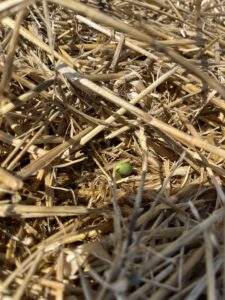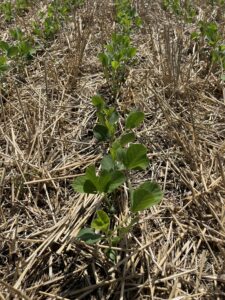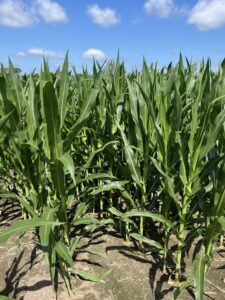Illinois Crop Update – July 18, 2025
Steve Brand– Commercial Agriculture Specialist
DeKalb County
Soil Conditions: Mildly Dry (soil is drier than normal, plant growth may have slowed)
The rains have finally arrived in northern IL with a handful of widespread storm events with more starting this weekend and pushing into next week. Most areas have reverted to D0 or D1 drought status and crops are doing well. Will county is the only area still in a D2 drought. With the rain and cooler temperatures in the forecast disease may finally start to creep into our corn and soybean plots, this late in the season generally won’t have a large impact on yields but scouting is still recommended through earfill in corn, as well as scouting for white mold and frogeye in soybeans.
Corn is tasseling across the I-80 corridor. Dekalb area was around 80% of fields at VT/R1, with the stragglers around V12/13 and spiking. Gray leaf spot is showing up in the lower leaves of multiple fields I scouted between Dekalb and Crystal Lake. This is also the weather Tar Spot thrives in being wet with intermittent rains and cooler temperatures overall. I would not be surprised if it is in fields in northern IL or develops quickly with the upcoming forecast. Scouting is your best measure to know if it’s in your fields as always. Corn overall is healthy, and I have not seen any fields with wind or hail damage despite the severe weather we have been seeing.
Soybeans are pushing along quickly through growth stages. Most bean fields I scouted are in R3 and nearing R4 very quickly if they aren’t already there. Disease is low currently, with small amounts of Japanese beetle damage, but nothing that will lead to economic loss. I will be scouting heavily for white mold, SDS, frogeye and other fungal diseases in coming weeks if the water has turned on and stays on.
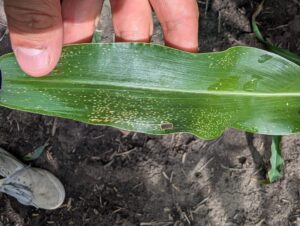
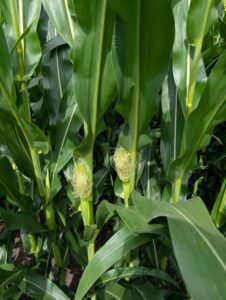
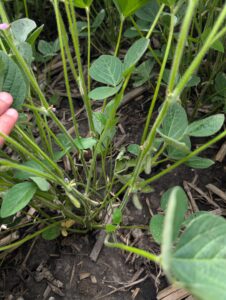
Emily Hansen – Commercial Agriculture Educator
LaSalle County
Soil Conditions: Near Normal
We received some much needed (if sporadic) rainfall in the last week that has crops looking much better than in previous weeks. Areas of Bureau County reported over 5 inches on Friday night, though that storm system petered out by the time it reached LaSalle County. LaSalle County did receive about 2 inches of rainfall on Wednesday night. Thankfully temperatures have also cooled off a little bit for the time being, and there is more rain in the forecast for this weekend and early into next week. Overall crops are looking healthy. Wheat in LaSalle County was harvested the first week of July. Most corn is now reaching VT/R1. Most soy is entering reproductive stages, with many fields at R3. I have not seen any serious disease or pest concerns in the fields that I have scouted, but tar spot has now been reported in LaSalle, Bureau, and Marshall counties, so growers should continue to scout fields and be on the lookout for this disease. Corn is reaching the growth stages where it could benefit from a fungicide application, and I have seen both ground and aerial sprayers at work in the past week.
Russ Higgins – Commercial Agriculture Educator
Grundy County
Soil Conditions: Severely Dry (soil is very dry, water bodies are very low, vegetation is stressed)
For a more upbeat report I would encourage you to read my coworker Steve Brands report. Last week in the area Steve covers in northern Illinois many fields received between 3 and 5 inches of rainfall. In areas including Kendall, Grundy and Will the rainfall totals measured in tenths. As many corn fields are at or nearing VT and R1 (tassel and silk stage), an expected result of the moisture stress is kernel abortion. Moisture stress at this time can interfere with pollen shed and silking synchronization. In addition, high temperatures coupled with low humidity can desiccate exposed silks. Can farmers evaluate the pollination process? After successful pollination and fertilization of the ovules, the silk will detach from the developing kernel. Evaluating pollination success can be done with the ear “shake test”. Carefully unwrap the husk and gently shake the ear, the silks from the fertilized future kernels will readily drop off. As long as we have kernels and green tissue for photosynthesis we can remain hopeful for the corn crop. Our soy crop, while visibly shorter this year in the dry fields, can recover more readily if forecast moisture alleviates growing conditions in this area.
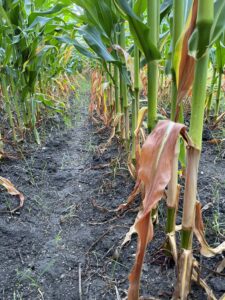
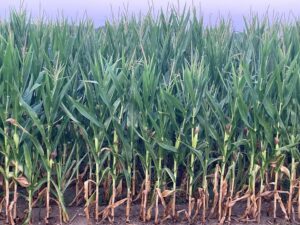
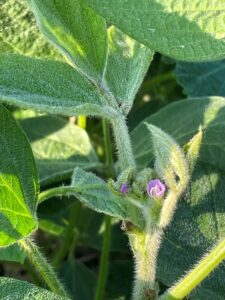
Reagan Tibbs – Commercial Agriculture Educator
Logan County
Soil Conditions: Mildly Dry (soil is drier than normal, plant growth may have slowed)
Last week has seen sporadic pop-up showers that have benefited some fields that needed a shot of rain to help growth and development in the reproductive stage. Few corn fields are in the late V-stages, while nearly all have tasseled, and ears are beginning to show. The same can be said with soybeans, with nearly all fields across the county in at least the R2 stage.
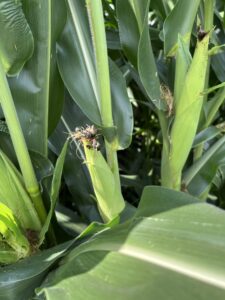
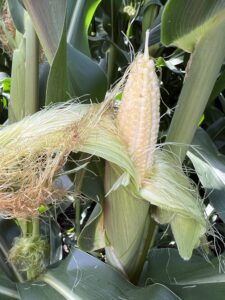
Doug Gucker – Local Food Systems and Small Farms Educator
Dewitt, Macon, and Piatt County
Soil Conditions: Moderately Dry (soil is dry, plants may be browning or stressed, water bodies are low)
It has been a tale of the “have and have-nots” with regard to rainfall. The far southern areas of Macon and Piatt Counties are at near to above normal rainfall levels, with the majority of the 3 counties hovering around 50% of normal rainfall.
In the dry areas, the grasshopper populations are increasing. Seeing some foliar feeding by Japanese beetles and grasshoppers, so far the levels are below the threshold for control.
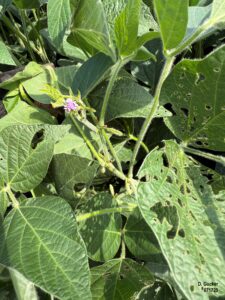
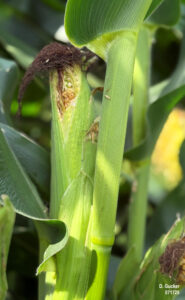
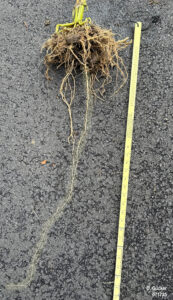
Nick Seiter – Extension Field Crops Entomologist
Champaign County
I have received a few reports of corn leaf aphid. This insect should be scouted prior to tasseling during late vegetative stages; if you have colonies of aphids formed on around 50% of plants at this time, you should consider an insecticide. Beneficial insects and fungal pathogens usually do a number on this pest. It takes extremely large populations to impact yield.
Dane Hunter – Commercial Agricultural Specialist
Marion County
Soil Conditions: Moderately Wet (soil is damp, standing water may be present in low areas, water bodies are full)
Spotty storms this week have dumped 1″-3″ of rain across Marion County after our longest stretch without precipitation since March. Our soils didn’t get dry exactly, but this moisture will help see the crop through the heat. This rain also helped even out some stands of double-crop soybeans in spots where the seed didn’t quite make it through the straw down into the soil and had yet to germinate. Most double-crop soybean fields I’ve seen are at V2 and looking good. First crop soybean are R1-R2 unless they were planted or replanted late. There were still planters rolling the first week of July, and those are more on pace with the double crops.
Corn in the area is still in vegetative growth stages, but you can feel the tassel forming down in the whorl, so VT is on the horizon.
